
- •About the Authors
- •Dedication
- •Authors’ Acknowledgments
- •Table of Contents
- •Introduction
- •What’s Not (And What Is) in This Book
- •Mac attack!
- •Who Do We Think You Are?
- •How This Book Is Organized
- •Part I: AutoCAD 101
- •Part II: Let There Be Lines
- •Part III: If Drawings Could Talk
- •Part IV: Advancing with AutoCAD
- •Part V: On a 3D Spree
- •Part VI: The Part of Tens
- •But wait . . . there’s more!
- •Icons Used in This Book
- •A Few Conventions — Just in Case
- •Commanding from the keyboard
- •Tying things up with the Ribbon
- •Where to Go from Here
- •Why AutoCAD?
- •The Importance of Being DWG
- •Seeing the LT
- •Checking System Requirements
- •Suddenly, It’s 2013!
- •AutoCAD Does Windows (And Office)
- •And They’re Off: AutoCAD’s Opening Screens
- •Running with Ribbons
- •Getting with the Program
- •Looking for Mr. Status Bar
- •Let your fingers do the talking: The command window
- •The key(board) to AutoCAD success
- •Keeping tabs on palettes
- •Down the main stretch: The drawing area
- •Fun with F1
- •A Simple Setup
- •Drawing a (Base) Plate
- •Drawing rectangles on the right layers
- •Circling your plate
- •Nuts to you
- •Getting a Closer Look with Zoom and Pan
- •Modifying to Make It Merrier
- •Hip-hip-array!
- •Stretching out
- •Crossing your hatches
- •Following the Plot
- •A Setup Roadmap
- •Choosing your units
- •Weighing up your scales
- •Thinking annotatively
- •Thinking about paper
- •Defending your border
- •A Template for Success
- •Making the Most of Model Space
- •Setting your units
- •Making the drawing area snap-py (and grid-dy)
- •Setting linetype and dimension scales
- •Entering drawing properties
- •Making Templates Your Own
- •Setting Up a Layout in Paper Space
- •Will that be tabs or buttons?
- •View layouts Quick(View)ly
- •Creating a layout
- •Copying and changing layouts
- •Lost in paper space
- •Spaced out
- •A view(port) for drawing in
- •About Paper Space Layouts and Plotting
- •Managing Your Properties
- •Layer one on me!
- •Accumulating properties
- •Creating new layers
- •Manipulating layers
- •Using Named Objects
- •Using AutoCAD DesignCenter
- •Copying layers between drawings
- •Controlling Your Precision
- •Keyboard capers: Coordinate input
- •Understanding AutoCAD’s coordinate systems
- •Grab an object and make it snappy
- •Other Practical Precision Procedures
- •Introducing the AutoCAD Drawing Commands
- •The Straight and Narrow: Lines, Polylines, and Polygons
- •Toeing the line
- •Connecting the lines with polyline
- •Squaring off with rectangles
- •Choosing your sides with polygon
- •(Throwing) Curves
- •Going full circle
- •Arc-y-ology
- •Solar ellipses
- •Splines: The sketchy, sinuous curves
- •Donuts: The circles with a difference
- •Revision clouds on the horizon
- •Scoring Points
- •Commanding and Selecting
- •Command-first editing
- •Selection-first editing
- •Direct object manipulation
- •Choosing an editing style
- •Grab It
- •One-by-one selection
- •Selection boxes left and right
- •Perfecting Selecting
- •AutoCAD Groupies
- •Object Selection: Now You See It . . .
- •Get a Grip
- •About grips
- •A gripping example
- •Move it!
- •Copy, or a kinder, gentler Move
- •A warm-up stretch
- •Your AutoCAD Toolkit
- •The Big Three: Move, Copy, and Stretch
- •Base points and displacements
- •Move
- •Copy
- •Copy between drawings
- •Stretch
- •More Manipulations
- •Mirror
- •Rotate
- •Scale
- •Array
- •Offset
- •Slicing, Dicing, and Splicing
- •Trim and Extend
- •Break
- •Fillet and Chamfer and Blend
- •Join
- •When Editing Goes Bad
- •Zoom and Pan with Glass and Hand
- •The wheel deal
- •Navigating your drawing
- •Controlling your cube
- •Time to zoom
- •A View by Any Other Name . . .
- •Looking Around in Layout Land
- •Degenerating and Regenerating
- •Getting Ready to Write
- •Simply stylish text
- •Taking your text to new heights
- •One line or two?
- •Your text will be justified
- •Using the Same Old Line
- •Turning On Your Annotative Objects
- •Saying More in Multiline Text
- •Making it with Mtext
- •It slices; it dices . . .
- •Doing a number on your Mtext lists
- •Line up in columns — now!
- •Modifying Mtext
- •Gather Round the Tables
- •Tables have style, too
- •Creating and editing tables
- •Take Me to Your Leader
- •Electing a leader
- •Multi options for multileaders
- •How Do You Measure Up?
- •A Field Guide to Dimensions
- •The lazy drafter jumps over to the quick dimension commands
- •Dimension associativity
- •Where, oh where, do my dimensions go?
- •The Latest Styles in Dimensioning
- •Creating and managing dimension styles
- •Let’s get stylish!
- •Adjusting style settings
- •Size Matters
- •Details at other scales
- •Editing Dimensions
- •Editing dimension geometry
- •Editing dimension text
- •Controlling and editing dimension associativity
- •Batten Down the Hatches!
- •Don’t Count Your Hatches. . .
- •Size Matters!
- •We can do this the hard way. . .
- •. . . or we can do this the easy way
- •Annotative versus non-annotative
- •Pushing the Boundary (Of) Hatch
- •Your hatching has no style!
- •Hatch from scratch
- •Editing Hatch Objects
- •You Say Printing, We Say Plotting
- •The Plot Quickens
- •Plotting success in 16 steps
- •Get with the system
- •Configure it out
- •Preview one, two
- •Instead of fit, scale it
- •Plotting the Layout of the Land
- •Plotting Lineweights and Colors
- •Plotting with style
- •Plotting through thick and thin
- •Plotting in color
- •It’s a (Page) Setup!
- •Continuing the Plot Dialog
- •The Plot Sickens
- •Rocking with Blocks
- •Creating Block Definitions
- •Inserting Blocks
- •Attributes: Fill-in-the-Blank Blocks
- •Creating attribute definitions
- •Defining blocks that contain attribute definitions
- •Inserting blocks that contain attribute definitions
- •Edit attribute values
- •Extracting data
- •Exploding Blocks
- •Purging Unused Block Definitions
- •Arraying Associatively
- •Comparing the old and new ARRAY commands
- •Hip, hip, array!
- •Associatively editing
- •Going External
- •Becoming attached to your xrefs
- •Layer-palooza
- •Creating and editing an external reference file
- •Forging an xref path
- •Managing xrefs
- •Blocks, Xrefs, and Drawing Organization
- •Mastering the Raster
- •Attaching a raster image
- •Maintaining your image
- •Theme and Variations: Dynamic Blocks
- •Lights! Parameters!! Actions!!!
- •Manipulating dynamic blocks
- •Maintaining Design Intent
- •Defining terms
- •Forget about drawing with precision!
- •Constrain yourself
- •Understanding Geometric Constraints
- •Applying a little more constraint
- •AutoConstrain yourself!
- •Understanding Dimensional Constraints
- •Practice a little constraint
- •Making your drawing even smarter
- •Using the Parameters Manager
- •Dimensions or constraints — have it both ways!
- •The Internet and AutoCAD: An Overview
- •You send me
- •Send it with eTransmit
- •Rapid eTransmit
- •Bad reception?
- •Help from the Reference Manager
- •Design Web Format — Not Just for the Web
- •All about DWF and DWFx
- •Autodesk Design Review 2013
- •The Drawing Protection Racket
- •Autodesk Weather Forecast: Increasing Cloud
- •Working Solidly in the Cloud
- •Free AutoCAD!
- •Going once, going twice, going 123D
- •Your head planted firmly in the cloud
- •The pros
- •The cons
- •Cloudy with a shower of DWGs
- •AutoCAD 2013 cloud connectivity
- •Tomorrow’s Forecast
- •Understanding 3D Digital Models
- •Tools of the Trade
- •Warp speed ahead
- •Entering the third dimension
- •Untying the Ribbon and opening some palettes
- •Modeling from Above
- •Using 3D coordinate input
- •Using point filters
- •Object snaps and object snap tracking
- •Changing Planes
- •Displaying the UCS icon
- •Adjusting the UCS
- •Navigating the 3D Waters
- •Orbit à go-go
- •Taking a spin around the cube
- •Grabbing the SteeringWheels
- •Visualizing 3D Objects
- •Getting Your 3D Bearings
- •Creating a better 3D template
- •Seeing the world from new viewpoints
- •From Drawing to Modeling in 3D
- •Drawing basic 3D objects
- •Gaining a solid foundation
- •Drawing solid primitives
- •Adding the Third Dimension to 2D Objects
- •Creating 3D objects from 2D drawings
- •Modifying 3D Objects
- •Selecting subobjects
- •Working with gizmos
- •More 3D variants of 2D commands
- •Editing solids
- •Get the 2D Out of Here!
- •A different point of view
- •But wait! There’s more!
- •But wait! There’s less!
- •Do You See What I See?
- •Visualizing the Digital World
- •Adding Lighting
- •Default lighting
- •User-defined lights
- •Sunlight
- •Creating and Applying Materials
- •Defining a Background
- •Rendering a 3D Model
- •Autodesk Feedback Community
- •Autodesk Discussion Groups
- •Autodesk’s Own Bloggers
- •Autodesk University
- •The Autodesk Channel on YouTube
- •The World Wide (CAD) Web
- •Your Local ATC
- •Your Local User Group
- •AUGI
- •Books
- •Price
- •3D Abilities
- •Customization Options
- •Network Licensing
- •Express Tools
- •Parametrics
- •Standards Checking
- •Data Extraction
- •MLINE versus DLINE
- •Profiles
- •Reference Manager
- •And The Good News Is . . .
- •APERTURE
- •DIMASSOC
- •MENUBAR
- •MIRRTEXT
- •OSNAPZ
- •PICKBOX
- •REMEMBERFOLDERS
- •ROLLOVERTIPS
- •TOOLTIPS
- •VISRETAIN
- •And the Bonus Round
- •Index
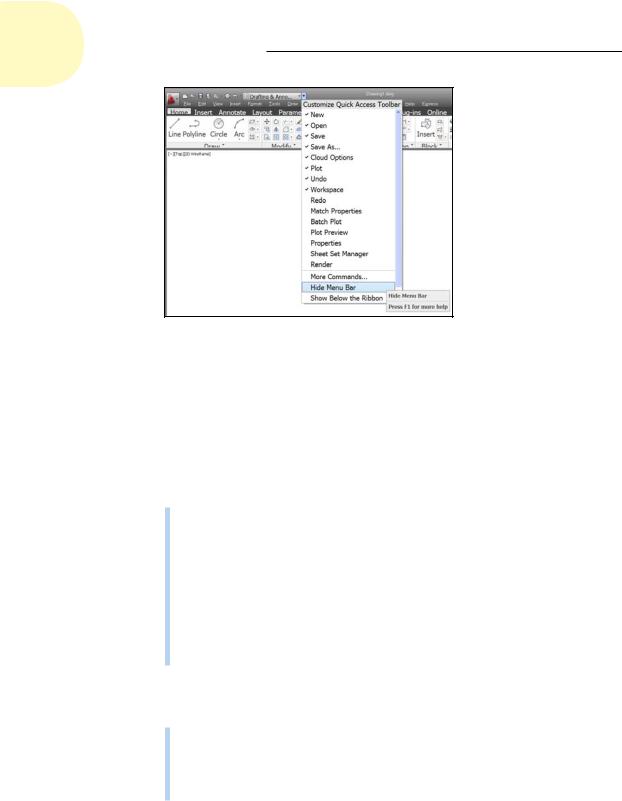
166 Part II: Let There Be Lines
Figure 8-1: You can display the classic menu bar if you want to.
The Straight and Narrow: Lines, Polylines, and Polygons
As we harp on a bunch of times elsewhere in this book, CAD programs are for precision drawing, so you’ll spend a lot of your AutoCAD time drawing objects composed of straight-line segments. The rest of this chapter covers these commands:
LINE (L): Draws a series of straight-line segments; each segment is a separate object.
PLINE (PL): Draws a polyline — a series of straightand/or curved-line segments. (Yes, I’m cheating a bit here — curvy things are covered in Chapter 9 — but we don’t want you to have to read about one command in two different places!) All the segments remain connected to each other as a single object.
RECTANG (REC): Draws a polyline in the shape of a rectangle.
POLYGON (POL): Draws a polyline in the shape of a regular polygon (that is, a closed shape with all sides equal and all angles equal).
The following additional straight-line drawing commands are also available in AutoCAD:
RAY: Draws a line that starts at a point and just keeps on going; a ray therefore is a line that extends infinitely in one direction.
XLINE (XL): Draws a line that passes through a point and extends infinitely in both directions. The question of the day is, which of these two lines is longer?
www.it-ebooks.info
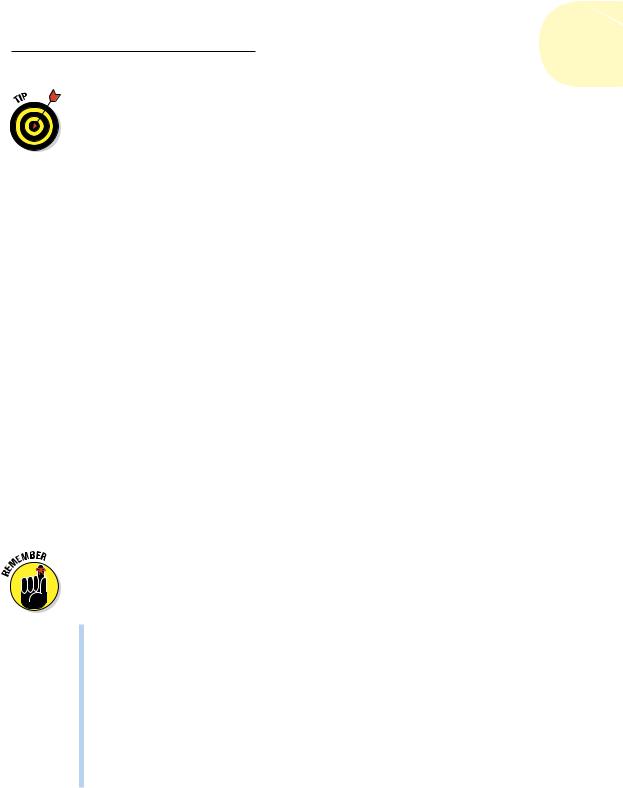
Chapter 8: Along the Straight and Narrow 167
The RAY and XLINE commands are used to draw construction lines that guide the construction of additional geometry. Drawing construction lines is less common in AutoCAD than in some other CAD programs. AutoCAD’s many precision techniques often provide more efficient methods for creating new geometry than adding construction lines to your drawing does. In particular, object snap tracking (discussed in Chapter 7) and parametrics (discussed in Chapter 19) usually eliminate all need for construction geometry or even for a mitre line when creating orthographic views.
Toeing the line
The LINE command in AutoCAD draws a series of one or more visually connected line segments. Although the lines appear to be physically connected, in fact, each segment, or piece of a line with endpoints, is a separate object. This construction doesn’t seem like a big deal until you try to move (or otherwise edit) a series of segments that you drew with the LINE command; you must select every piece separately. To avoid such a hassle, use polylines (described in the following section), not lines (or lines and arcs), when you want the connected segments to act as a single object.
If you’re used to drawing lines in other programs, you may find it confusing at first that AutoCAD’s LINE command doesn’t stop after you draw a single segment. AutoCAD keeps prompting you to specify additional points so that you can draw a series of (apparently) connected segments. When you’re finished drawing segments, just press Enter to finish the LINE command.
Unlike a lot of the AutoCAD drawing commands, LINE doesn’t offer a bunch of potentially confusing options. It has a Close option to create a closed polygonal shape and an Undo option to remove the most recent segment that you drew.
Like all drawing commands, LINE puts the line segments that it draws on the current layer and uses the current color, linetype, lineweight, transparency, and plot-style properties. When you’re doing real drafting, as opposed to just experimenting, make sure of the following:
Think about setting these properties before you start drawing.
Although you can easily change an object’s layer or other object properties, it’s often more efficient to set properties first. (We recommend that you set color, linetype, lineweight, transparency, and, if you’re using named plot styles, plot style to ByLayer.) See Chapter 6 for information on setting the current properties with the tools on the Home tab’s Properties panel.
Use the right precision tools. Make sure that you use one of AutoCAD’s precision tools, such as object snaps, typed coordinates, or tracking, to ensure that you specify each object point precisely. Chapter 7 describes these tools.
www.it-ebooks.info

168 Part II: Let There Be Lines
Follow these steps to draw a series of line segments by using the LINE command:
1.Set an appropriate layer to be current.
2.Click the Home tab on the Ribbon.
The panels on the Home tab contain the most commonly used commands in AutoCAD.
3.Click the Line button on the Draw panel of the Ribbon’s Home tab, or type L and press Enter.
AutoCAD starts the LINE command and prompts you to select the first point.
4.Specify the starting point by clicking a point or typing coordinates.
Remember to use one of the precision techniques we describe in Chapter 7 if you’re doing real drafting. For the first point, you can type coordinates, pick a precise point if snap is turned on, or use object snap if other objects already exist in the drawing. AutoCAD prompts you
to specify the other endpoint of the first line segment. The command window prompt shows
Specify next point or [Undo]:
You can also see command prompts at the Dynamic Input tooltip beside the crosshairs by pressing the down-arrow key (press F12 or click the Dynamic Input status bar button to enable Dynamic Input mode). The arrow icon on the Dynamic Input tooltip is your indicator that there are options available.
5.Specify additional points by clicking or typing.
Again, use one of the AutoCAD precision techniques if you’re doing real drafting. For the second and subsequent points, all the techniques mentioned in Step 4 work well, as do ortho, polar, object snap tracking, and direct distance entry.
After you specify the third point, AutoCAD adds the Close option. The command prompt shows
Specify next point or [Close/Undo]:
6.When you’re finished drawing segments, end with one of these steps:
•Keep the figure open. Either press Enter, or right-click anywhere in the drawing area and choose Enter from the right-click menu to leave the figure open.
•Close the figure. Type C and press Enter, or press the down arrow on your keyboard and choose Close from the menu (shown in Figure 8-2) to close the figure.
www.it-ebooks.info
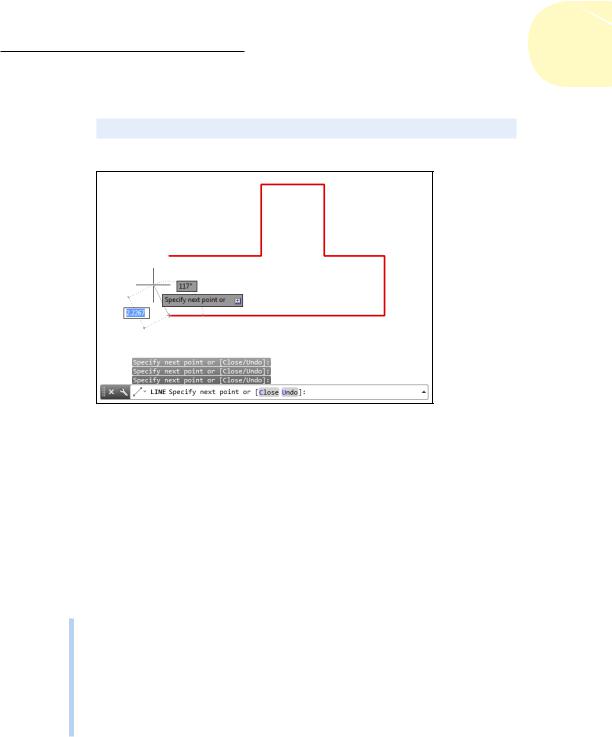
Chapter 8: Along the Straight and Narrow 169
In either case, the blank command prompt indicates that the LINE command is finished:
Command:
Figure 8-2: Line it up — drawing line segments with the LINE command.
Connecting the lines with polyline
The LINE command is fine for many drawing tasks, but the PLINE command is better for others. Experience will help you to choose. The PLINE command draws a special kind of object called a polyline. You may hear CAD drafters refer to a polyline as a pline (rhymes with beeline) because of the command name. This has nothing to do with the queue at a busy restroom.
The most important differences between the LINE and PLINE commands are these:
The LINE command draws a series of separate line segments. Even though they appear to be connected on the screen, each segment is a separate object. If you move one line segment, the other segments that you drew at the same time don’t move with it.
The PLINE command draws a single, connected, multisegment object.
If you select any segment for editing, your changes affect the entire polyline. Figure 8-3 shows how the same sketch drawn with the LINE and the PLINE commands responds when you select one of the objects.
www.it-ebooks.info
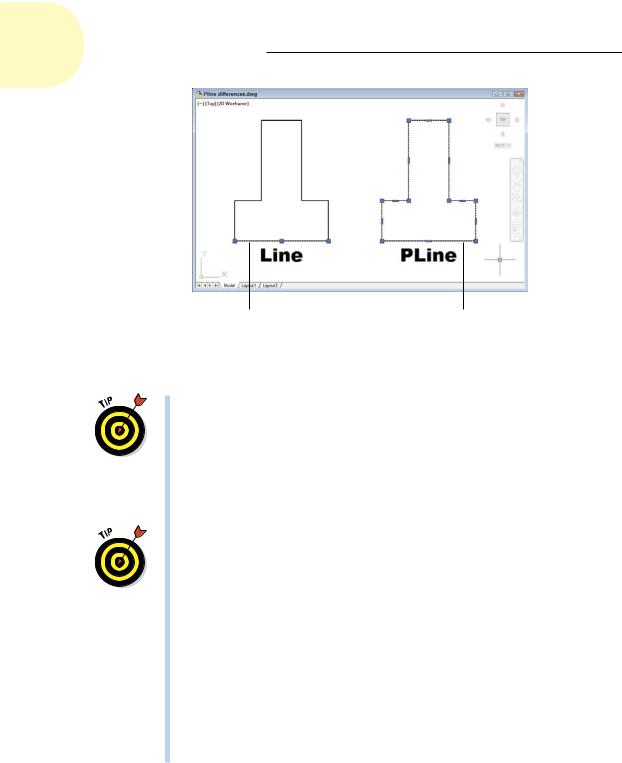
170 Part II: Let There Be Lines
Each segment is |
All segments |
a separate object. |
form one object. |
Figure 8-3: Results of drawing with the LINE and PLINE commands.
Use PLINE rather than LINE in most cases where you need to draw a series of connected line segments. If you’re drawing a series of end-to- end segments, there’s a good chance that those segments are logically connected — for example, they might represent the outline of a single object or a continuous pathway. If the segments are connected logically, it makes sense to keep them connected in AutoCAD. The most obvious practical benefit of grouping segments together into a polyline is that many editing operations are more efficient when you use polylines. When you select any segment in a polyline for editing, the entire polyline is selected.
As covered in Chapter 19, using parametrics on line segments can often produce the same results as using a PLINE.
The PLINE command can draw curved segments as well as straight ones. If you want a combination of separate linear and curved segments, you must switch back and forth between the LINE and ARC commands (we cover arcs in Chapter 9). With PLINE, you can switch between linear or circular-curve sections by choosing the command options described in the steps that come after this list.
Polylines can have width. Polyline segment width is visually similar to AutoCAD’s lineweight object property, except that polyline width can vary from segment to segment, and individual segments can be tapered. But wait! There’s more! After drawing a polyline, you can have it automatically reshape itself into a smooth, flowing curve based on the vertex points you selected.
www.it-ebooks.info

Chapter 8: Along the Straight and Narrow 171
After you create a polyline, you can adjust its segments by grip editing any of the vertex points. (The little squares on the vertices in Figure 8-3 are called grips; see Chapter 10 for details on grip editing.) For more complicated poly- line-editing tasks, you can use the PEDIT command to edit the polyline, or you can convert the polyline to a collection of line and arc segments by using the EXPLODE command — although you lose any width defined for each segment when you explode a polyline. For more information on these two commands, look them up in the index of the online help.
Drawing polylines composed of straight segments is pretty much like drawing with the LINE command, as demonstrated in the following procedure.
The PLINE command has lots of options, so watch the prompts! If Dynamic Input is on, use the down-arrow key to see the options listed near the crosshairs, or right-click to display the PLINE right-click menu, or simply read the command line.
To draw a polyline composed of straight segments, follow these steps:
1.Set an appropriate layer to be current.
2.Click the Polyline button on the Ribbon’s Draw panel or type PL and press Enter.
AutoCAD starts the PLINE command and prompts you to specify a start point.
3.Specify the starting point by clicking a point or typing coordinates.
AutoCAD displays the current polyline segment line width at the command line and prompts you to specify the other endpoint of the first polyline segment:
Current line-width is 0.0000
Specify next point or [Arc/Halfwidth/Length/Undo/
Width]:
4.If the current line width isn’t zero, change it to zero by typing W to select the Width option, and then entering 0 as the starting and ending widths, as shown in the following command-line sequence:
Specify next point or [Arc/Halfwidth/Length/Undo/Width]: W
Specify starting width <0.0000>: 0
Specify ending width <0.0000>: 0
Specify next point or [Arc/Halfwidth/Length/Undo/
Width]:
Despite what you may think, a zero-width polyline segment isn’t the AutoCAD equivalent of drawing with invisible ink. Zero width means “display this segment using the normal, single-pixel width on the screen and plot as thin as possible.”
5. Specify additional points by clicking or typing.
www.it-ebooks.info
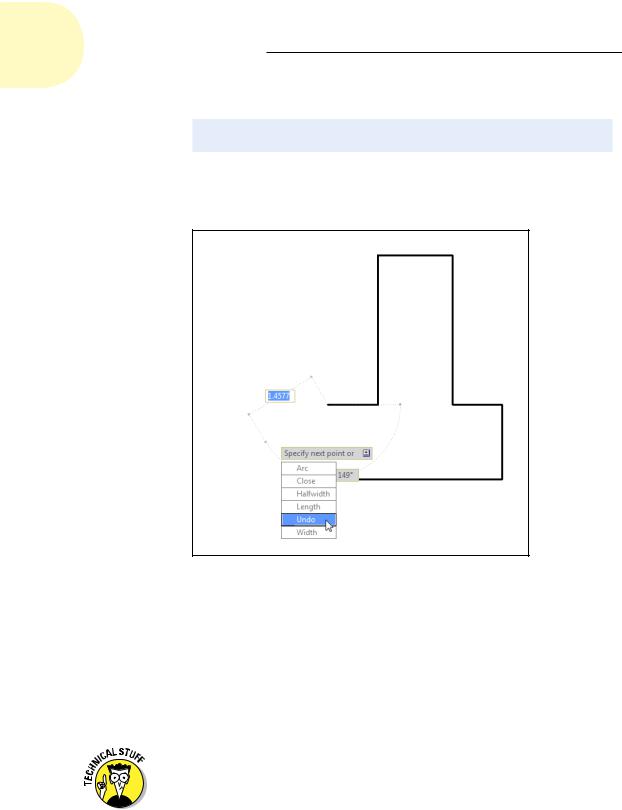
172 Part II: Let There Be Lines
After you specify the second point, AutoCAD adds the Close option to the prompt. The command line shows
Specify next point or [Arc/Close/Halfwidth/Length/ Undo/Width]:
In addition, you can view and choose options from the Dynamic Input options list, shown in Figure 8-4, by pressing the down arrow on your keyboard.
Figure 8-4: Making a PLINE.
6.After you finish drawing segments, either press Enter (to leave the figure open) or type C and press Enter (to close it).
AutoCAD draws the final segment. The blank command line indicates that the PLINE command is finished.
In the following procedure, we spice things up a bit and give you a preview of coming (curvy) attractions (in Chapter 9) by adding an arc segment to a polyline.
Just so you know, curved segments in polylines are circular arcs — pieces of circles with center points that you can draw with AutoCAD’s ARC command. AutoCAD can draw other kinds of curves, including ellipses and splines, but not within the PLINE command.
www.it-ebooks.info
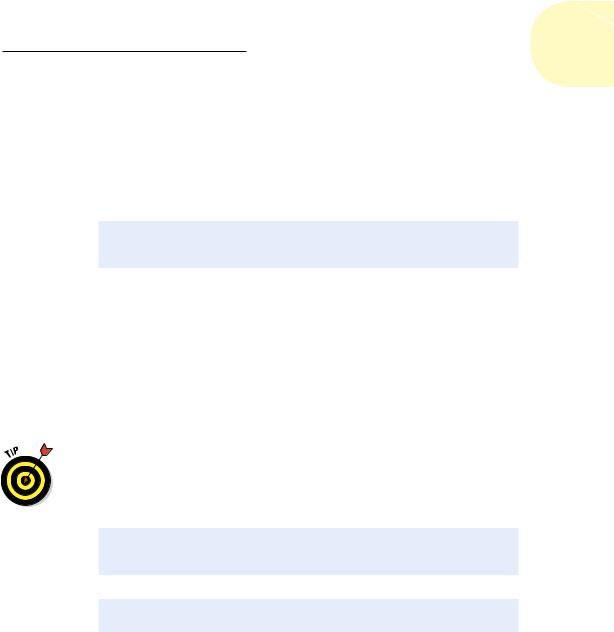
Chapter 8: Along the Straight and Narrow 173
To draw a polyline that includes curved segments, follow these steps:
1.Repeat Steps 1 through 5 of the previous procedure.
2.When you’re ready to add one or more arc segments, type A and press
Enter to select the Arc option.
The prompt changes to show arc segment options. Most of these options correspond to the many ways of drawing circular arcs in AutoCAD; see the section on arcs in Chapter 9. The command line shows
Specify endpoint of arc or [Angle/CEnter/CLose/ Direction/Halfwidth/Line/Radius/Second pt/Undo/Width]:
3.Specify the endpoint of the arc by clicking a point or typing coordinates.
AutoCAD draws the curved segment of the polyline. The prompts continue to show arc segment options.
Your options at this point include
•Specifying additional points to draw more arc segments
•Choosing another arc-drawing method (such as Center or Second pt)
•Returning to drawing straight-line segments with the Line option
In this example, you return to drawing straight-line segments.
Perhaps the most useful of the alternative arc-drawing methods is Second pt. That gives you more control over the direction of the arc, but at the cost of losing tangency of adjacent segments. Sometimes it’s best not to go off on a tangent, anyway.
4. Type L and press Enter to select the Line option.
Specify endpoint of arc or [Angle/CEnter/CLose/
Direction/Halfwidth/Line/Radius/Second pt/
Undo/Width]: L
The prompt changes back to showing straight-line segment options.
Specify next point or [Arc/Close/Halfwidth/Length/
Undo/Width]:
5.Specify additional points by clicking or typing.
6.After you’re finished drawing segments, either press Enter, or type C and press Enter.
Figure 8-5 shows some of the things that you can draw with the PLINE command by using straight segments, arc segments, varying-width segments, or a combination of all of them.
www.it-ebooks.info
